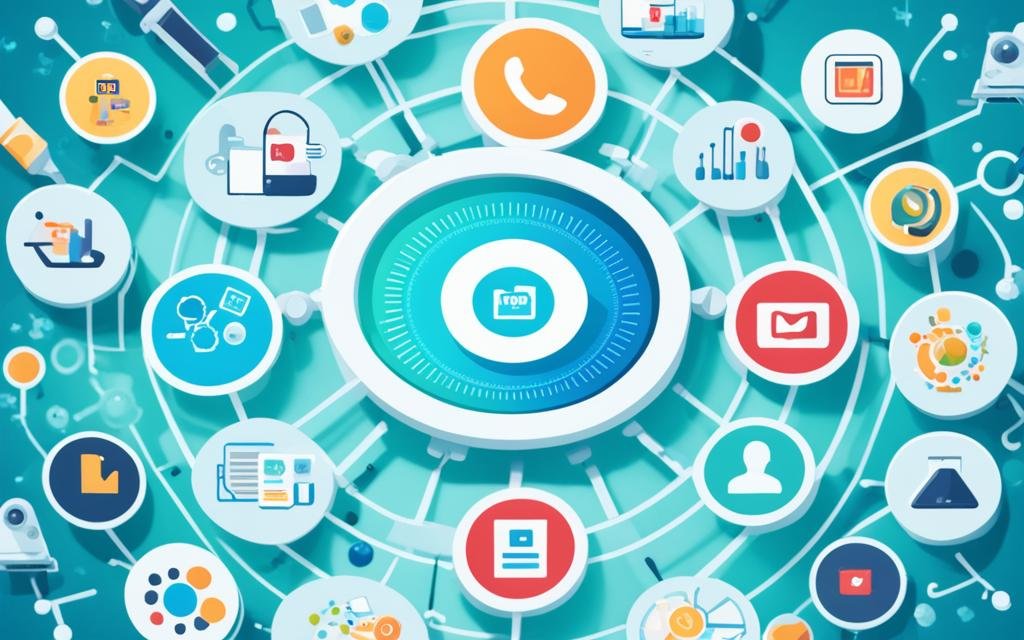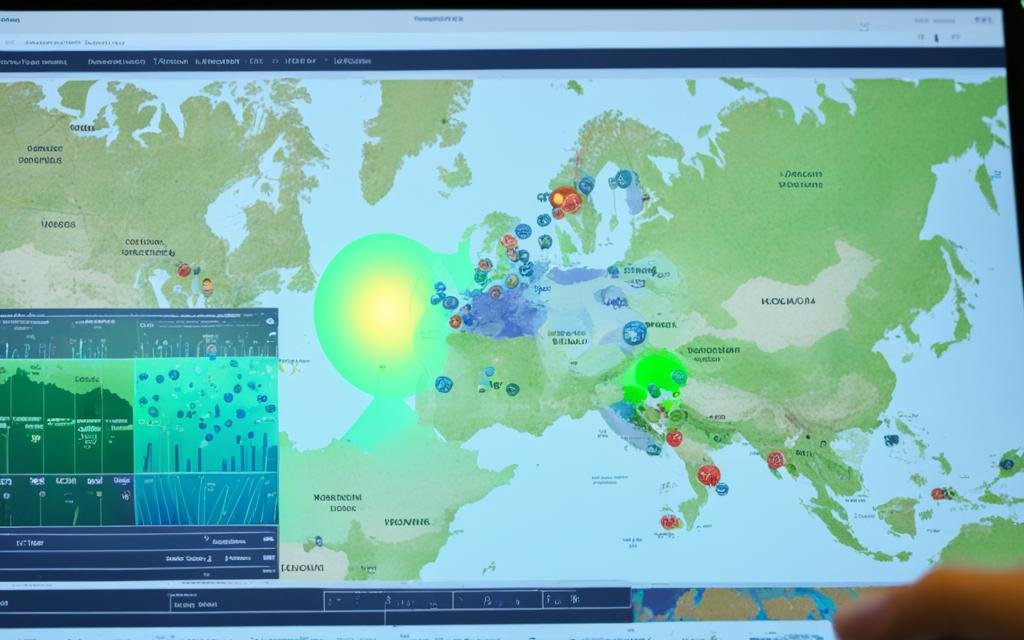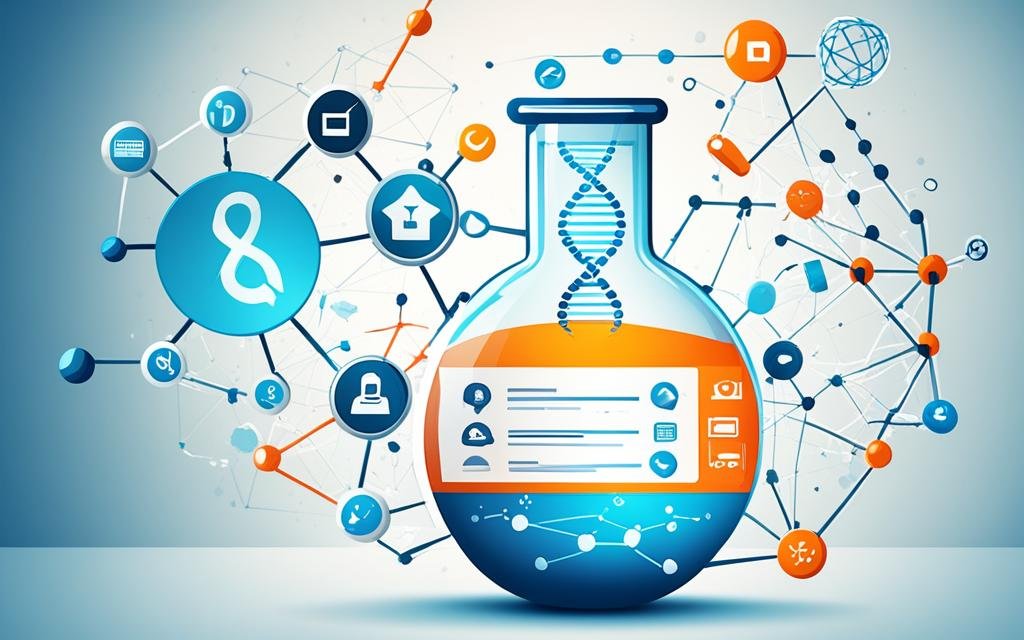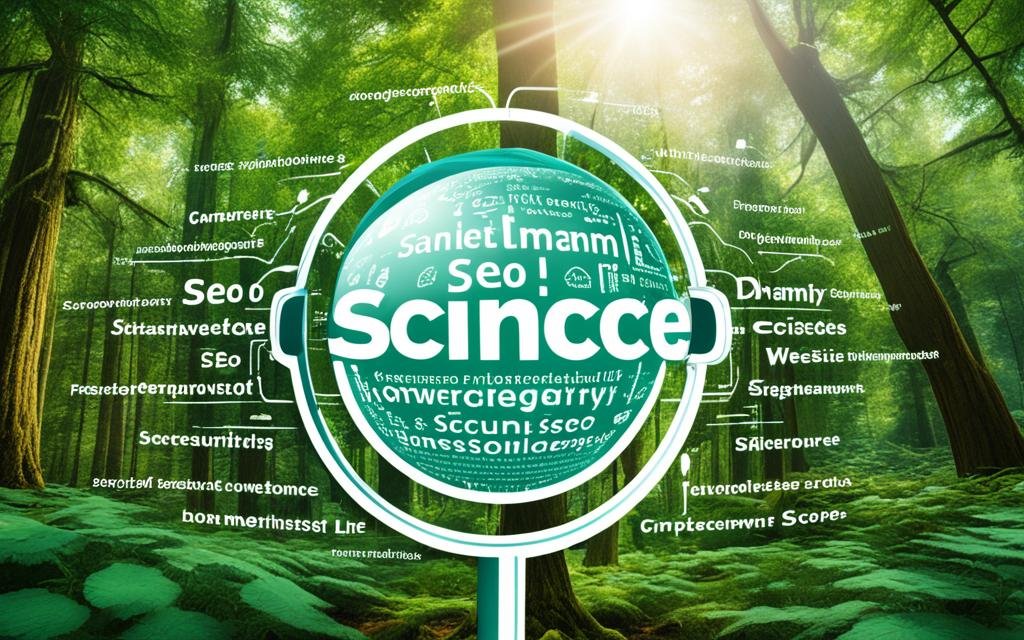In the fast-changing world of life sciences, digital marketing is a key to growing your business. It helps you reach more people and grow. With targeted campaigns and data analysis, digital marketing changes the game. You’ll learn the strategies and tactics that lead to success in this field.
Hubspot says 70% of marketers use content marketing to engage and inform their audience. By making content like blog posts and research articles, you build trust with potential customers. In fact, 81% of people need to trust a brand before buying, showing how crucial digital marketing is for building relationships.

The life sciences industry is getting more competitive, with new tech changing everything. To stay ahead, having a strong digital marketing plan is key. It lets you connect with people on a personal level. By sharing valuable info and building relationships, you boost brand awareness, customer loyalty, and sales. Without a strong online presence, you could lose out to competitors who use digital marketing well.
When diving into digital marketing for life sciences, remember to think about rules and compliance. Working with experts in life science marketing can help you meet these challenges. They know about branding, content, SEO, social media, and getting leads. By focusing on the customer journey and using data, you can get more conversions, loyal customers, and growth.
Key Takeaways
- Digital marketing is a key way to grow your reach and business in life sciences.
- Content marketing, SEO, and social media are important for reaching your audience.
- Trust and credibility with customers are key to selling more and keeping customers.
- A good digital marketing plan helps you connect with people and build relationships.
- Working with experts in life science marketing can help with rules and use their knowledge.
The Importance of Digital Marketing in the Life Sciences Industry
In today’s digital world, the life sciences industry is very competitive. R&D investments grow faster than the market. To stay ahead, companies need to use digital marketing strategies. These strategies must follow strict rules and engage with their audience well.
This audience includes healthcare specialists, patients, medical staff, researchers, scientists, regulatory bodies, and investors.

Digital marketing is key for life sciences companies to reach more people, build brand awareness, and engage customers better. They use social media, email marketing, and search engine optimization to get noticed. It’s important to make these strategies fit the needs and interests of each group.
Personalized marketing is a big part of success in the life sciences. Using data and analytics, companies can make campaigns that speak to their audience. This approach leads to more engagement and sales. It also helps companies see what works and plan better for the future.
Personalized content delivery based on customer data enhances customer satisfaction and value perception.
Another big trend is omnichannel marketing in life sciences. This means a smooth experience for customers across all touchpoints, like websites, social media, email, and mobile apps. By using a unified brand message across channels, companies can connect with their audience better and build strong relationships.
Life sciences companies are also using interactive marketing to engage patients more. Techniques like quizzes, polls, and virtual reality experiences grab attention and offer insights into what patients like. This helps companies tailor their marketing and improve patient care.
- Invest in data-driven marketing strategies
- Personalize content for each target audience
- Adopt an omnichannel approach for consistent messaging
- Leverage interactive marketing techniques to engage patients
- Continuously measure and optimize marketing efforts
The life sciences industry is always changing. Companies that focus on digital marketing and adapt will do well. By using data, personalizing content, and engaging patients with new methods, life sciences companies can stand out and achieve great results.
How Digital Transformation Has Impacted the Life Sciences Industry
The life sciences industry has changed a lot in recent years. This change is thanks to the fast growth of digital technologies. These changes have touched many parts of the industry, like research, patient care, and working together. Now, life sciences companies can do better in the digital healthcare world.

Research and Development
Digital changes have greatly affected research and development in life sciences. By using data and advanced analytics, companies can make drug discovery faster and more accurate. For instance, Takeda worked with Deloitte to use AI to improve disease prediction models. This made their predictions nearly 40% more accurate.
Improved Patient Care
Using digital tech has made patient care better in life sciences. Telemedicine lets patients get healthcare at home, cutting down on visits. EHRs also help share patient info, letting doctors make better decisions and give care that fits each patient.
Precision Medicine
Digital changes have made precision medicine possible in life sciences. By looking at lots of patient data, doctors can make treatments just for each patient. This means better treatment results and fewer side effects.
Collaboration and Innovation
Digital tools have helped life sciences work together and innovate. Researchers can share data and ideas easily, speeding up discoveries. Digital tools also let companies talk to healthcare workers and patients in new ways, like through special marketing and support programs.
| Digital Transformation Aspect | Impact on Life Sciences Industry |
|---|---|
| Research and Development | Accelerated drug discovery and improved prediction accuracy |
| Patient Care | Telemedicine, remote monitoring, and personalized care |
| Precision Medicine | Targeted therapies based on individual patient data |
| Collaboration and Innovation | Increased data sharing, cross-organizational collaboration, and innovative patient engagement |
Even with the good things about digital change, life sciences companies face challenges. These include worries about data privacy, following rules, and having a good digital plan. By tackling these issues and using a business-focused approach to digital change, life sciences companies can use digital tech fully. This helps them stay ahead in the changing healthcare world.
Benefits of Digital Marketing in the Life Sciences Industry
The life sciences industry has seen the power of digital marketing. It changes how companies talk to their audience. Digital marketing brings many benefits that help life sciences grow and connect better with people.

Increased Brand Visibility and Awareness
Digital marketing helps life sciences brands get noticed more. By using digital channels, companies show their products and expertise to more people. This makes them stand out and attract new customers and partners.
Targeted Marketing Campaigns
Digital marketing lets companies target their ads better. With SEO and social media, life sciences can reach specific groups of people. This means their messages hit the right audience, leading to more engagement and sales.
Improved Customer Engagement
Digital marketing helps life sciences companies talk to customers in new ways. Through interactive content and social media, they build strong connections. This leads to customers who trust and support the brand.
Measurable Results
Digital marketing is easy to track. It gives life sciences companies clear data on their campaigns. This lets them see what works and make smart choices to improve their marketing.
| Benefit | Impact |
|---|---|
| Increased brand visibility | Attracts potential customers and partners |
| Targeted marketing campaigns | Higher engagement and conversion rates |
| Improved customer engagement | Builds trust and loyalty |
| Measurable results | Data-driven decision making |
Cost-Effectiveness
Digital marketing is also more affordable for life sciences. It’s cheaper than old ways of advertising. By using targeted ads and social media, companies can reach more people without spending a lot. This helps them use their marketing money better and get a good return on investment.
By converting customers while reducing cost per acquisition, the life sciences industry can improve revenue and return on investment.
In conclusion, digital marketing is a big win for the life sciences. It boosts brand awareness, targets the right people, and engages customers better. With clear results and cost savings, life sciences companies can make smart choices and grow in the digital world.
Key Strategies for Digital Marketing in the Life Sciences Industry
Digital marketing is key in life sciences to reach people, get leads, and make brands known. With a growth rate of 12.75% from 2022 to 2029, using the right marketing strategies is crucial. Personalized marketing helps build trust and credibility, leading to your goals.

To stand out in life sciences, you need a full digital marketing plan. This includes content marketing, SEO, social media, and email campaigns. Each part is important for engaging your audience and getting results.
Setting clear marketing objectives is vital for success; marketing objectives should be specific, measurable, attainable, relevant, and time-bound to align with overall business objectives.
When making your marketing plan, think about these key parts:
- Make content that educates and builds trust with potential customers.
- Make your website and content easy to find online to get more visitors.
- Use social media to talk with your audience, share important info, and get your brand out there.
- Email marketing helps nurture leads, send focused messages, and increase conversions.
- Video marketing helps explain complex ideas and makes your brand more visible.
- Influencer marketing uses industry leaders to increase credibility and reach.
| Digital Marketing Channel | Key Benefits |
|---|---|
| Content Marketing | Shows you’re a leader, educates people, and brings in visitors |
| Search Engine Optimization | Makes your website easier to find, brings in good leads, and boosts trust in your brand |
| Social Media Marketing | Connects with your audience, spreads the word about your brand, and builds a community |
| Email Marketing | Helps grow leads, sends focused messages, and boosts conversions |
| Video Marketing | Makes complex ideas clear, increases brand visibility, and engages people |
| Influencer Marketing | Uses industry experts, builds trust, and reaches more people |
By using these strategies and digital marketing, you can reach your audience, build strong relationships, and get great results in the life sciences industry.
Content Marketing for Life Sciences
In the life sciences industry, content marketing is key. It helps build brand awareness, sets you up as a thought leader, and connects with your audience. By making valuable content, you share your expertise and show how you solve healthcare challenges for professionals and patients.

Creating Valuable and Engaging Content
To win in life sciences content marketing, make content that speaks to your audience. Focus on their problems, offer insights, and give solutions. Use data to tell stories that show your knowledge and draw in potential customers. Here are some stats to consider:
- 73% of B2B marketers in life sciences use content marketing in their digital strategies.
- About 62% of B2B buyers in life sciences look at 3 to 7 content pieces before talking to a salesperson.
- Companies with blogs in life sciences get 68% more leads than those without blogs.
Utilizing Various Content Formats
Use different content formats to meet various learning styles and keep people interested. Add infographics to make information quick to understand. Create videos that touch emotions and show how your solutions help patients. Don’t forget about blog posts, whitepapers, and e-books for detailed info and to prove your expertise.
Optimizing Content for Search Engines
Make sure your content is easy to find by optimizing it for search engines. Do thorough keyword research to find what your audience is looking for. Add these keywords to your content, including titles and meta descriptions. This will help you rank better in searches and bring in more qualified visitors.
Promoting Content Through Multiple Channels
Promoting your content is just as important as making it. Use many channels to reach more people and engage with your audience. Share on social media like LinkedIn and Twitter. Join industry forums and online groups to share your insights. Work with influencers to spread your message wider and make it more credible.
Measuring Content Marketing Effectiveness
It’s key to check how well your life sciences content marketing is doing. Look at website traffic, how engaged people are, lead generation, and customer conversions. Use analytics to see what your audience likes and adjust your content. This way, you can make smart choices and use your resources well.
Content marketing in life sciences takes time and effort for the best results, beating quick campaigns.
Content marketing in life sciences has big benefits. It’s 62% cheaper than old marketing ways, making it a smart choice for leads. Also, it turns leads into customers nearly six times better than not using it, showing its power in converting visitors.
| Content Marketing Benefit | Impact |
|---|---|
| Cost-effectiveness | 62% less costly than traditional marketing methods |
| Lead generation | Businesses with blogs generate 68% more leads |
| Conversion rates | Nearly 6 times higher for content marketing adopters |
| Customer retention and trust | Familiarity through content increases brand trust and loyalty |
With a good life sciences content marketing plan, you can connect with your audience, build trust, and get great results for your business.
Search Engine Optimization for Life Sciences Websites
Search engine optimization (SEO) is key to making life sciences websites more visible and higher in search rankings. By using life sciences SEO strategies, you can draw in more visitors, get leads, and grow your business.

Conducting Keyword Research
Good SEO starts with finding the right keywords. You need to know what words and phrases people use to look for your products or services. Adding these keywords to your website makes it more relevant and helps you rank better for those searches.
Optimizing Website Structure
A well-organized website is good for both search engines and people. Make sure your site has a clear layout, easy navigation, and friendly URLs. This helps search engines understand and index your site better and makes users happy, keeping them around longer.
Creating Quality Content
Great content is the heart of life sciences SEO. Create content that’s unique, well-researched, and helpful to your audience. Use keywords in a way that’s easy to read and informative.
Quality content, including research findings and educational resources, is crucial for SEO success in the life sciences industry.
On-Page Optimization
On-page optimization makes each page of your website more visible and relevant to search engines. Work on meta titles, descriptions, header tags, image alt tags, and how you link within your site. Using the right keywords in these areas boosts your SEO.
Building High-Quality Backlinks
Backlinks from respected life sciences websites help your site rank better. Try guest blogging, fixing broken links, and making content that people naturally want to link to. The quality and relevance of backlinks matter more than how many you have.
| SEO Strategy | Impact on Life Sciences Websites |
|---|---|
| Keyword Research | Identifies relevant keywords to attract targeted traffic |
| Website Structure Optimization | Improves crawlability and user experience |
| Quality Content Creation | Increases organic traffic and establishes brand authority |
| On-Page Optimization | Enhances visibility and relevance to search engines |
| High-Quality Backlink Building | Boosts search engine rankings and domain authority |
Using these life sciences website optimization tips can really help your site rank better, bring in more visitors, and make your brand a leader in life sciences.
Social Media Marketing in the Life Sciences Industry
Social media is key for life sciences companies to connect with people, build their brand, and get people involved. With 77% of Americans on social media and 88% of companies having a social media account, life sciences need to use this tool to stay ahead.

Good social media marketing for life sciences means making content that matters, having a clear brand, and joining in on industry talks. Sharing helpful posts, educational stuff, and updates can make a company stand out. This helps build strong bonds with customers, patients, and partners.
Building conversations through social media can help establish strong relationships with customers due to the relaxed nature of the platform.
Here are tips to make your life sciences social media work better:
- 40% engaging content to spark conversations and encourage interaction
- 30% promotional content to showcase your products, services, and achievements
- 20% educational content to provide value and establish your expertise
- 10% curated content from reputable sources to supplement your own posts
For a professional social media presence, remember these tips:
- Set up profiles on platforms like LinkedIn, Facebook, and Twitter
- Post regularly to keep your audience thinking of you
- Work with influencers to gain trust and get more content
- Make sure your profiles are full of contact info and promote your accounts
- Use targeted ads to reach specific groups and get a good return on investment
| Social Media Platform | Best Practices |
|---|---|
| Share industry insights, join relevant groups, and engage in professional discussions | |
| Create a company page, share behind-the-scenes content, and respond to customer inquiries | |
| Participate in industry hashtags, share real-time updates, and engage with followers | |
| Showcase visually compelling content, utilize stories and reels, and collaborate with influencers |
With a strong social media plan, life sciences companies can get more visibility, target their marketing, engage with customers better, and see clear results. Use social media to connect with your audience, build trust, and succeed in the changing life sciences world.
Email Marketing for Life Sciences
Email marketing is key for life sciences companies to connect with their audience and meet their marketing goals. 81% of B2B life sciences companies use email marketing to nurture leads. It’s a powerful way to drive conversions and build strong customer relationships.
To boost your email marketing, focus on targeted campaigns. Send content that matters to specific parts of your audience. Use lists based on job titles, research interests, or brand engagement to tailor your messages.
Targeted Campaigns
Targeted emails get better open and click rates in life sciences than broad emails. Personalize your content and subject lines to grab attention. Here are some strategies for targeted campaigns:
- Conduct market research to guide your segmentation
- Use data analytics to personalize content on a large scale
- Write clear, relevant subject lines to boost engagement
- Add visuals like images or videos to make content stand out
- Use strong calls to action to encourage action
| Metric | Average for Pharmaceutical Email Campaigns (2022) |
|---|---|
| Open Rate | 18.58% |
| Click Rate | 2.25% |
Keep an eye on metrics like open rates, click-through rates, and conversions to improve your campaigns. Test different subject lines, content, and calls-to-action to see what works best with your audience.
Compliance
Make sure your email marketing follows the rules and respects privacy laws in life sciences. Get consent before adding people to your list, make unsubscribing easy, and keep their data safe.
GDPR can fine companies up to 4% of their annual revenue or €20 million. HIPAA violations can lead to fines and even jail time.
Work with legal and compliance teams to make sure your marketing follows the law. This might mean adding more security, updating your privacy policy, or training your team on handling data and consent.
Putting compliance and data security first in your email marketing builds trust with your audience. It also protects your company’s reputation over time.
Best Practices for Life Sciences Digital Marketing
To stand out in life sciences digital marketing, following industry best practices is key. These guidelines help you connect with your audience, build trust, and get meaningful results for your company.

Regulatory Compliance
Following regulatory rules is crucial in life sciences marketing. All your marketing must meet FDA, GDPR, and international standards. Staying compliant avoids legal trouble and shows you’re serious about ethics.
Various rules and regulations must be followed in life science marketing such as FDA guidelines, GDPR compliance, and international standards.
Data-Driven Decision Making
Using data analytics is vital for smart decisions in life sciences digital marketing. It helps you track how well your campaigns do, improve your strategies, and use your resources wisely. Important metrics to watch include:
- Website traffic and engagement
- Lead generation and conversion rates
- Social media metrics (likes, shares, comments)
- Email open and click-through rates
- Content performance (views, downloads, shares)
| Marketing Channel | Key Metrics |
|---|---|
| Website | Traffic, engagement, conversion rates |
| Social Media | Likes, shares, comments, follower growth |
| Open rates, click-through rates, conversions | |
| Content | Views, downloads, shares, engagement |
By looking at these metrics, you can understand what your audience likes. This helps you make smart choices to improve your marketing strategies.
Patient-Centric Approach
Putting patients first is key to trust and engagement in life sciences. Focus on what patients need and how your products help them. Highlight the benefits and share stories of success to make your brand more relatable.
Engaging content is vital for driving users to websites and building relationships in life science marketing.
By using these best practices, you can handle the complex world of life sciences marketing. You’ll make sure to follow the rules, use data to guide you, and focus on patients for lasting success.
Digital Marketing for Life Sciences
In the life sciences industry, digital marketing is key for brand awareness, sales leads, and revenue growth. The global life science market was worth US $92.2 billion in 2020 and is growing at 11.9% annually until 2028. To stay ahead, businesses need strong digital marketing strategies.

First, know your business goals. Identify who you want to reach, whether new or current customers. This helps you focus your marketing to engage and keep them interested. It’s about making campaigns that speak to your audience.
Different target audiences require diverse content styles, formats, and tones.
Having a strong online presence is crucial for digital marketing success in life sciences. Each website and client has unique needs. Working with marketing agencies that know the life sciences can help you meet these challenges and reach your goals.
| Agency | Specialization | Target Clients |
|---|---|---|
| Digital Elevator | Small business biotechs | Nearly 15 years of industry presence |
| Supreme | Digital marketing and website development | Mid-market to large enterprises |
| Samba Scientific | Lead generation campaigns, webinar management, conference lead generation | Small businesses |
| BioStrata | Brand awareness, lead generation, product launches | Mid-market to large enterprises |
| Forma Life Science Marketing | Brand strategy and implementation | Mid-market to large enterprises |
| Orientation Marketing | Traditional and digital marketing services | Small businesses to mid-market enterprises |
| Patrick Wareing | Content creation, SEO, digital marketing training | Small businesses |
To boost your life sciences digital marketing, use a mix of owned, earned, paid, and social channels. This approach helps you reach more people, build trust, and be seen as a leader in the industry.
The life sciences industry is growing fast, with markets like microscopy aiming for over US $1.5 billion by 2026. Investing in good digital marketing is crucial. With the right marketing experts and data insights, you can set your business up for success in this fast-changing market.
Conclusion
In today’s fast-changing digital world, success in life sciences marketing depends on knowing the industry well and having a solid plan. Using strategies like content marketing, thought leadership, SEO, social media, email, and webinars helps you tackle the life sciences sector with confidence. Remember, 83% of consumers want a deep connection with brands that show empathy and support. So, adding a personal touch to your marketing is key.
Starting your life sciences marketing journey, focus on making decisions based on data and putting patients first. With fewer face-to-face meetings with healthcare pros lately, use technology to connect with them on a personal level. But, remember the challenges life sciences companies face because of rules and aim for a balance between using tech and giving the best experience to consumers.
The future of life sciences marketing looks promising, with AI helping create targeted campaigns and better communication. By keeping up with trends, improving your strategies, and working well with sales, you can set your company up for long-term success. Use the power of digital marketing, stay flexible, and always think about what your audience needs.
FAQ
What is the importance of digital marketing in the life sciences industry?
Digital marketing is key for life sciences companies. It helps them reach more people, build brand awareness, and engage with customers better. By using digital channels, companies can get noticed, draw in potential customers, and stay ahead in the digital world.
How has digital transformation impacted the life sciences industry?
Digital transformation has changed the life sciences for the better. It has made things more efficient, improved patient care, and boosted innovation. Digital tools have sped up drug development, made healthcare easier to access, and helped researchers work together better.
What are the benefits of digital marketing for life sciences companies?
Digital marketing brings many benefits to life sciences companies. It helps increase brand recognition and targets specific groups of people. It also improves customer interaction, is more cost-effective than old marketing ways, and lets companies track how well their marketing works.
What are some key strategies for effective content marketing in the life sciences industry?
For effective content marketing in life sciences, focus on making content that solves problems for your audience. Use different types of content like blogs, whitepapers, and videos. Make sure your content is easy to find online, share it through various channels, and check how well it’s doing.
How can life sciences companies optimize their websites for search engines?
To make life sciences websites search engine friendly, start with keyword research. Then, improve your website’s structure and content. Get links from trusted sources and keep an eye on your site to make it better over time.
What role does social media marketing play in the life sciences industry?
Social media marketing lets life sciences companies share news quickly, talk to customers and experts right away, and get their brand out there. Good social media plans include having a strong online presence, sharing useful content, using interactive tools, and talking with followers.
What are some best practices for life sciences digital marketing?
For life sciences digital marketing, follow these best practices. Make sure you follow the rules, use data to guide your decisions, and focus on what patients need. Staying compliant, using data to improve your marketing, and putting patients first are key to gaining trust and engaging with people.

0 Comments